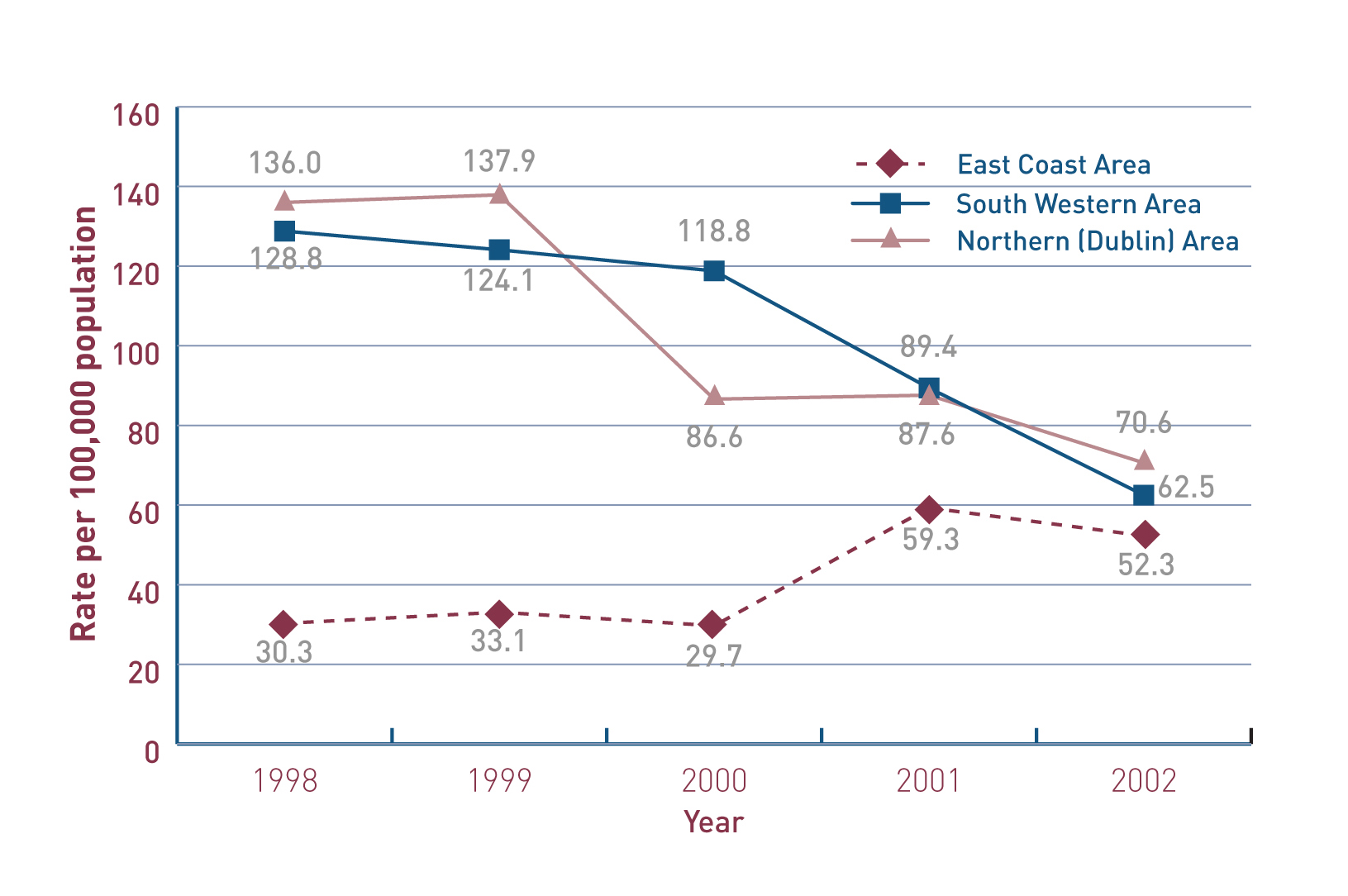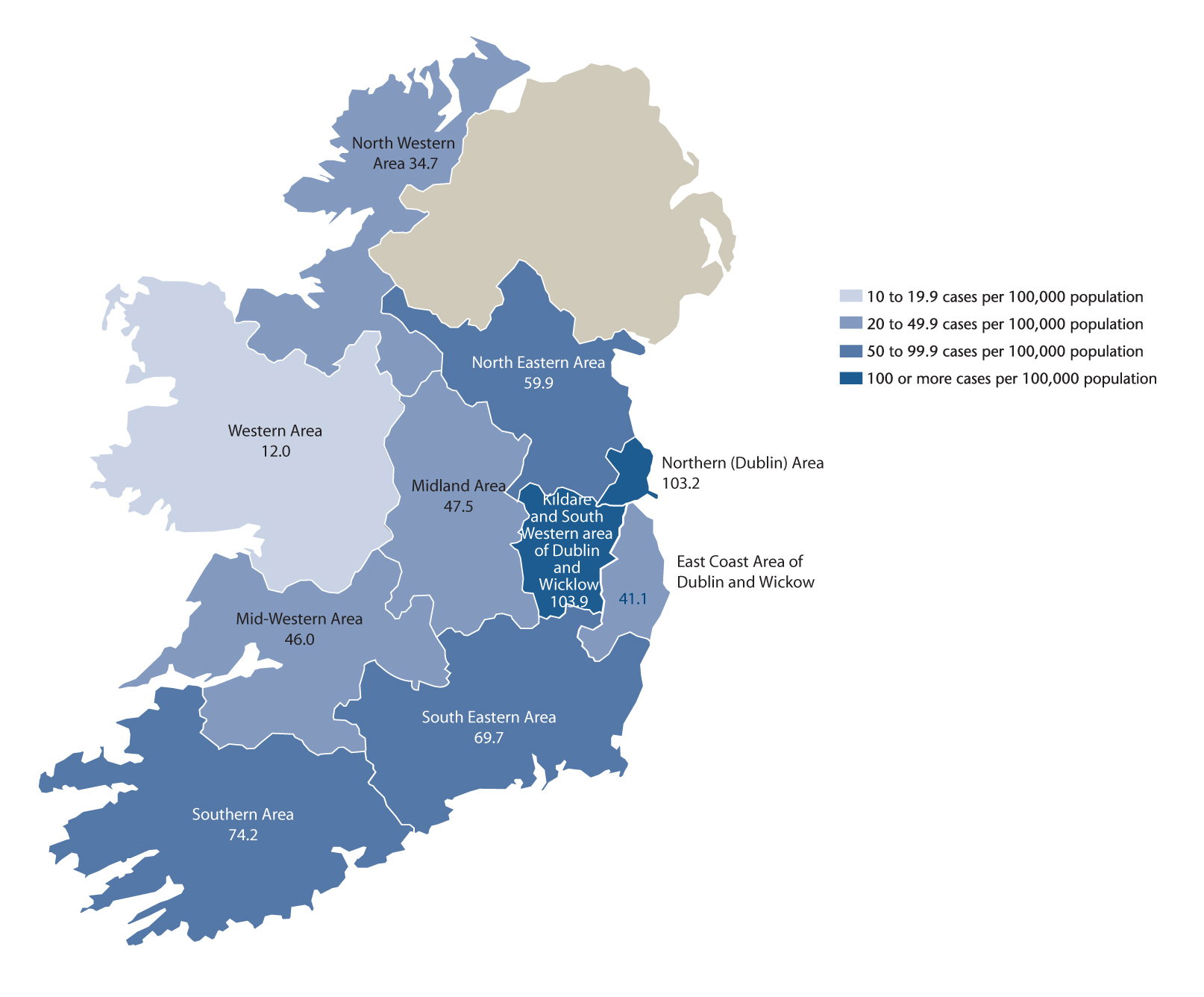Long, Jean (2005) Publication of occasional papers on treated drug use in the HSE Eastern Region and nationally, 1998 to 2002. Drugnet Ireland, Issue 15, Autumn 2005, pp. 13-14.
| Preview | Title | Contact |
|---|---|---|
|
PDF (Drugnet Ireland, issue 15)
- Published Version
402kB |
Three occasional papers were published by the Drug Misuse Research Division in this quarter.
Occasional Paper No. 151 provides a description of demand for drug treatment services in the HSE Eastern Region (Dublin, Kildare and Wicklow) provided by the Drug Treatment Centre Board, the HSE East Coast Area (of Dublin and Wicklow), the HSE South Western Area (of Dublin and Wicklow and all of Kildare) and the HSE Northern (Dublin) Area. The total number of cases treated increased by almost 20 per cent in the HSE Eastern Region between 1998 and 2002, with the largest increase occurring in the HSE Northern (Dublin) Area, where numbers rose by 62 per cent, from 1,154 in 1998 to 1,871 in 2002. In the HSE South Western Area, the increase was also considerable, at 50 per cent, from 1,621 in 1998 to 2,407 in 2002. The total number of cases treated by the Drug Treatment Centre Board decreased by more than one quarter in the five-year period. The Drug Treatment Centre Board is a tertiary service which provides advice to referring practitioners on the management of clients with complex problems and provides treatment for clients with more serious drug problems or co-morbid psychiatric illness. Therefore, a number of clients attending this Centre are assessed only and then referred back to their practitioner (with advice on future management) or referred to another more appropriate treatment provider. In the three HSE areas in the HSE Eastern Region, the number of drug treatment services increased, as did the demand for such services.
Occasional Paper No. 162 provides a description of trends in treated problem drug use among cases living in the HSE Eastern Region. Of the 27,674 cases treated for problem drug use and living in the HSE Eastern Region between 1998 and 2002, 4,871 (18%) were treated for the first time. Overall, the total number of cases increased by 23 per cent over the five-year period. There was an increase in the number and proportion of previously treated cases, from 3,815 (75%) in 1998 to 5,324 (85%) in 2002. There was a steady decrease in the number and proportion of new cases, from 1,140 (22%) in 1998 to 790 (13%) in 2002. The increase in the total numbers can be attributed to the fact that the numbers continuing in and returning to treatment were increasing by a larger rate than the number of new cases entering treatment in each year. This suggests that the increased service provision was to a large extent able to cope with demand for drug treatment services from persons living in the HSE Eastern Region. Between 1998 and 2002, opiates were the most common main problem drug reported by both new and previously treated cases in the region. The total number of cases living in the region who reported opiates as their main problem drug increased by 27 per cent, from 4,652 in 1998 to 5,921 in 2002, and opiates dominated the main problem drug profile among treated cases living in this area. The number of new cases treated who reported problem opiate use decreased by 29 per cent, from 912 in 1998 to 648 in 2002. The incidence of treated problem drug use among persons aged between 15 and 64 years living in the HSE East Coast Area (of Dublin and Wicklow) increased by 73 per cent, from 30 per 100,000 in 1998 to 52 per 100,000 in 2002 (Figure 1). The incidence in the HSE South Western Area (of Dublin and Wicklow and all of Kildare) halved, from 129 per 100,000 in 1998 to 63 per 100,000 in 2002 and the incidence in the HSE Northern (Dublin) Area almost halved also, from 136 per 100,000 in 1998 to 71 per 100,000 in 2002.

Figure 1 Incidence of treated problem drug use among persons aged between 15 adn 64 years living in the HSE Eastern Region, per 100,000 population (Central Statistics Office 2003), based on returns to the NDTRS, 1998-2002
Occasional Paper No. 173 provides a description of trends in treated problem drug use among cases living in Ireland. The total numbers include 33,391 cases who lived and were treated in Ireland between 1998 and 2002. During the reporting period, opiates were the most frequently reported main problem drug, while cannabis was the second most frequently reported main problem drug by treated cases in Ireland. The number of new cases treated who reported problem opiate use decreased by 21 per cent, from a peak of 922 in 1999 to 729 in 2002. The number of new cases treated who reported problem cannabis use increased by 144 per cent, from 379 in 1998 to 925 in 2002. The numbers of new cases treated who reported cocaine as their main problem drug, though small, increased consistently between 1999 and 2002. The incidence rates of treated problem drug use among persons aged between 15 and 64 years living in Ireland, expressed per 100,000 of the population, was examined by county for the period 1998 to 2002 (Figure 2). The incidence rates were highest in Carlow, Dublin and Waterford (with over 100 cases per 100,000 of the population aged 15 to 64 years), followed by Cork, Louth, Meath, Westmeath, Sligo, Tipperary and Limerick (with between 50 and 99 cases per 100,000). Excluding Sligo, the incidence rates were lowest in western counties (with between 10 and 19 cases per 100,000).

Figure 2 Average annual incidence of treated problem drug use among persons aged 15 to 64 years living in Ireland, by HSE area, based on returns to the NDTRS per 100,000 of the population, 1998 to 2003 (Central Statistics Office 2003)
1. Kelly F, Lynn E and Long J (2005) Treatment demand in the Health Service Executive Eastern Region, 1998 to 2002. Occasional Paper No. 15. Dublin: Health Research Board.
2. Kelly F, Long J and Lynn E (2005) Trends in treated problem drug use in the Health Service Executive Eastern Region, 1998 to 2002. Occasional Paper No. 16. Dublin: Health Research Board.
3. Long J, Lynn E and Kelly F (2005) Trends in treated problem drug use in Ireland, 1998 to 2002. Occasional Paper No. 17. Dublin: Health Research Board.
Repository Staff Only: item control page